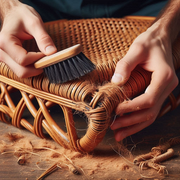Any house gains a little natural charm from rattan furniture. Its adaptable style and lightweight, robust character make it a popular choice for both inside and outside décor. To keep rattan’s beauty and use, nevertheless, it needs regular maintenance and periodic repairs—just like any material.
We will go over the best ways to care for rattan furniture and offer thorough instructions for fixing typical problems in this complete guide.
Taking Care of Your Rattan Furniture
Here’s how:
Regular Process of Cleaning
Regularly cleaning your rattan furniture will help to keep its appearance. The dull look of the rattan comes from the dirt and dust that build up within its crevices. That may also lead to gradual damage to the rattan.
- DUSTING: Dusting the rattan’s surface calls for a delicate brush or microfiber cloth. Give the woven sections where dust can readily build extra care.
- VACUUMING: Using a vacuum cleaner with a brush attachment can help you to thoroughly clean the crevices by gathering dust and trash.
- WIPING DOWN: Wipe down the rattan once a month using a moist cloth and mild soapy water. Steer clear of wetting the rattan; too much moisture might destroy it. After cleaning, let the furniture air dry totally by removing any extra water with a dry cloth.
Guarding Against Sunlight and Moisture
Direct sunshine and too much moisture can either cause rattan to dry out, becoming brittle, or grow mold and mildew.
- SUNLIGHT: Arrange rattan furniture out from direct sunlight or filter the light with drapes and shades. If you use rattan outside, think about shifting it to a shaded spot in the warmest of the days.
- MOISTURE: Keep a dry surroundings for rattan furniture. Make sure the furniture is covered or kept indoors during wet seasons if it will be used outdoors. Should furniture become wet, completely dry it to stop mildew and mold from developing.
Using Protective Coatings
One should think about using a protective coating to safeguard rattan furniture even more. This can improve the rattan’s look and longevity.
- Apply a coat of varnish or lacquer to the rattan’s surface to guard it from UV radiation and moisture. Based on degree of exposure, this should be done once a year or as needed.
Repairing Rattan Furniture
In case your rattan items get damage, here are ways to repair them:
Fixing Loose Strands
 Some strands of rattan could loosen or break over time. Quick resolution of these problems helps to stop more damage.
Some strands of rattan could loosen or break over time. Quick resolution of these problems helps to stop more damage.
- Re-tucking loose strands back into the weave with a small, blunt tool like a butter knife. To hold the threads in place, dab a tiny bit of wood glue.
- If a strand breaks or disappears, use a fresh piece of rattan. To make the fresh strand malleable, soak it in water; then, weave it into the furniture in the original design. Use wood glue to secure the ends; cut any extra.
Fixing Split and Crack
Drying or collision causes splits and cracks in rattan furniture. Fixing these right away will help the furniture to remain structurally sound.
- FILLING CRACKS: Using wood filler can help you to close minor cracks and splits. Sand the filler down to provide a smooth surface after it dries. Epoxy resin will help to bond shattered pieces together for more sizable breaks.
- REINFORCING SPLITS: Apply the resin to the split, clamped the pieces together, and let it cure per manufacturer directions.
Final Thoughts
Any house gains a classic and natural appeal from rattan furniture, but it needs appropriate upkeep to remain in best shape. Your rattan pieces will stay beautiful and useful for years to come if you follow consistent cleaning schedules, cover the furniture from sunshine and moisture, and take quick care of any damages. Your rattan furniture will keep improving your home décor and offer comfort and style for many seasons with little effort and upkeep.

